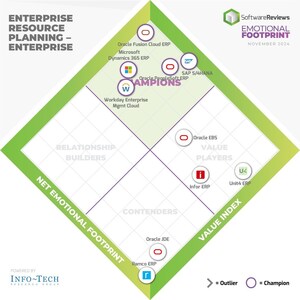The process of navigating from waterfall to Agile can be challenging. Info-Tech Research Group advises in a newly released industry resource that organizations must be deliberate when aligning their Agile and requirements management practices to leverage their efforts into a powerful combination of the two disciplines.
TORONTO, May 12, 2023 /PRNewswire/ - Agile has been a buzzword for organizations for quite some time, with the temptation to deemphasize good requirements practices in favor of perceived speed often going hand-in-hand with the move toward Agile. However, if organizations are unable to deliver on the needs of the business throughout this process shift, then they have failed, regardless of how fast they've moved to implement Agile practices. Info-Tech Research Group advises that it is possible to use both the waterfall and Agile disciplines to achieve success. In its latest industry blueprint, Manage Requirements in an Agile Environment, the IT research and advisory firm offers organizational leaders an understanding of the two disciplines, support in finding balance in their approach, and insights into preparing for new ways of working.
Agile was supposed to be the saving grace of project delivery but is often misunderstood as taking the short-term view of "going quickly" at the expense of important elements. These elements include team formation and interaction, stakeholder engagement and communication, timing and sequencing of analysis work, decision making, documentation, and dealing with change.
"Delivery in Agile doesn't mean you stop needing solid business analysis. In fact, it's even more critical to ensure your products and projects are adding value. With the rise of Agile, the role of the business analyst has been misunderstood," says Vince Mirabelli, principal research director, Applications Delivery & Management at Info-Tech Research Group. "As a result of misunderstanding Agile, we often throw out the analysis with the bathwater, thinking we'll be just fine without analysis, documentation, and deliberate action, as the speed and dexterity of Agile are enough. Consequently, what we get is wasted time, money, and effort, with solutions that fail to deliver value or that need to be re-worked to get right."
In Agile, the "what" of business analysis does not change, but the "how" and "when" that work happens, do. To combat the struggle of balancing waterfall and Agile, in the new blueprint, Info-Tech has broken down the requirements process framework into three sprint phases. These phases are:
- Sprint N(-1) – This phase of the sprint includes gathering and documenting requirements and the prioritization of said requirements.
- Sprint N – Phase two of the sprint requires defining acceptance criteria and supporting testing and quality assurance (QA).
- Sprint N(+1) – The third and final phase of the sprint involves managing changing requirements and collaboration with stakeholders.
The firm's resource also highlights four key areas of consideration for organizational leaders looking to pursue Agile:
- Collaboration – Many subject matter experts are necessary to create accurate requirements, but their time is limited.
- Communication – Stakeholders should be kept informed throughout the requirements-gathering process. Organizations must be sure to get the right information to the right people.
- Documentation – Recording, organizing, and presenting requirements are essential. However, excessive documentation will slow delivery time.
- Control – Establishing control points in the requirements-gathering process can help confirm, verify, and approve requirements accurately, though stage gates can limit delivery.
Info-Tech advises that by combining the two disciplines, organizational leaders will need to focus on emphasizing flexibility, enabling continuous delivery, enhancing collaboration and communication, and developing a user-centered approach.
"The best organizations find balance between these two forces, to align and gain the benefits of both Agile and business analysis, working in tandem to manage requirements that bring solutions that are 'just right'," explains Mirabelli.
To access the full blueprint, including tracking metrics recommended to help organizations measure progress and the firm's methodology for Agile requirements, download Manage Requirements in an Agile Environment.
For more information about Info-Tech Research Group or to view the latest research, visit infotech.com and connect via LinkedIn and Twitter.
Info-Tech Research Group is one of the world's leading information technology research and advisory firms, proudly serving over 30,000 IT professionals. The company produces unbiased and highly relevant research to help CIOs and IT leaders make strategic, timely, and well-informed decisions. For more than 25 years, Info-Tech has partnered closely with IT teams to provide them with everything they need, from actionable tools to analyst guidance, ensuring they deliver measurable results for their organizations.
Media professionals can register for unrestricted access to research across IT, HR, and software and over 200 IT and industry analysts through the Media Insiders program. To gain access contact [email protected].
SOURCE Info-Tech Research Group

WANT YOUR COMPANY'S NEWS FEATURED ON PRNEWSWIRE.COM?
Newsrooms &
Influencers
Digital Media
Outlets
Journalists
Opted In






Share this article